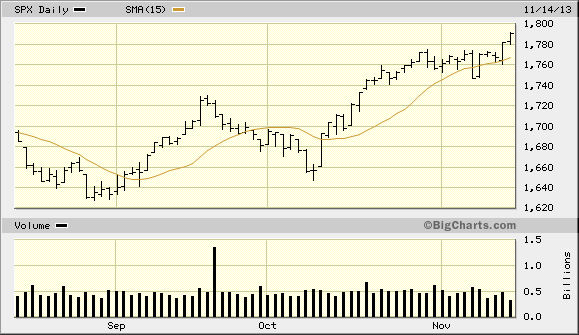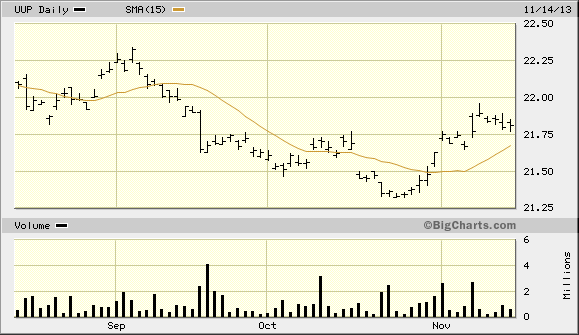QE - Fed Official Admits Failure
Stock-Markets / Quantitative Easing Nov 15, 2013 - 10:10 AM GMTBy: Clif_Droke

 Apologies are becoming increasingly common these days. From the ubiquitous “Twitter apologies” of celebrities to the mea culpas of scandalized politicians, the public has become used to hearing them on a daily basis. It came as a surprise, however, when a former Federal Reserve official apologized for the part he played in the ultra-loose monetary policy known as QE.
Apologies are becoming increasingly common these days. From the ubiquitous “Twitter apologies” of celebrities to the mea culpas of scandalized politicians, the public has become used to hearing them on a daily basis. It came as a surprise, however, when a former Federal Reserve official apologized for the part he played in the ultra-loose monetary policy known as QE.
“Confessions of a Quantitative Easer,” the Wall Street Journal published the public apology by former Fed official Andrew Huszar. The gist of the piece can be summarized in Huszar’s words: “We went on a bond-buying spree that was supposed to help Main Street. Instead, it was a feast for Wall Street.”
Huszar claims responsibility for executing the bond-buying experiment known as quantitative easing. Despite his prior knowledge that the Fed’s independence from Wall Street was eroding, an observation that caused him to walk away from a previous Fed job, Huszar heeded a call to return in order to oversee the Fed’s mortgage purchases. He described it as a “dream job.”
After the first round of QE ended in early 2010, Huszar summarized the final results in these words: “While there had been only trivial relief for Main Street, the U.S. central bank's bond purchases had been an absolute coup for Wall Street. The banks hadn't just benefited from the lower cost of making loans. They'd also enjoyed huge capital gains on the rising values of their securities holdings and fat commissions from brokering most of the Fed's QE transactions. Wall Street had experienced its most profitable year ever in 2009, and 2010 was starting off in much the same way.”
He freely admits that the Fed should have stopped QE after the first round, acknowledging that the “flash crash” in May 2010 prompted the Fed to continue with its QE experiment. The relationship between Wall Street and the central bank was becoming more and more entrenched and it was simply too late to turn back, according to Huszar. This is when he decided to return to the private sector, claiming he had been “demoralized” by the failure of QE to lift the economy.
Nearly four years later the large financial market intervention in world history has cost $4 trillion and still hasn’t resulted in the predicted boost for Main Street. Wall Street by contrast continues to enjoy the liquidity bonanza, with stocks consistently making new highs on a monthly basis. Pimco’s CEO Mohammed El Erian suggests that for its efforts the Fed may have received a return of only 0.25% of GDP in return for the $4 trillion spent. Commenting on this, Huszar concedes that “QE isn’t really working.”
Huszar concluding statement is candid: “As for the rest of America, good luck. Because QE was relentlessly pumping money into the financial markets during the past five years, it killed the urgency for Washington to confront a real crisis: that of a structurally unsound U.S. economy.”
Now compare Huszar’s frank admission with the latest words from Janet Yellen, the heir-apparent to chair the Federal Reserve next year. On Wednesday she stated that the Fed still has “more work to do” to stimulate the economy. That of course was all Wall Street needed to hear in order to boost participant’s morale and push stock prices higher. The S&P 500 Index (SPX) ended the session by closing at a new all-time high.

“I believe that supporting the recovery today is the surest path to returning to a more normal approach to monetary policy,” said Yellen. These remarks led traders to believe that the Fed would continue its ultra-loose monetary policy well into 2014, which is extremely desirable to Wall Street. This underscores that the Fed is committed to pursuing a continued aggressively loose monetary policy indefinitely. Traders need not fear any attempts at “tapering” QE, either next month or in the next few months. It will take considerably more “evidence” before the Fed is ready to scale back its asset purchases next year.
The bigger issue in Huszar’s confession is the failed relationship between the stock market and the economy. Prior to the credit crisis it was widely assumed that the connection between equity market strength and domestic economic performance was relatively tight. That relationship is now being questioned after the last five years of continued stimulus with little results for Main Street despite Wall Street’s record performance. This isn’t to say the relationship is forever broken, only that the lesson from the Great Depression years is being repeated, viz. when the deflationary long-term cycles are down, stocks and the economy typically move at difference paces.
Gold
Many analysts believe that gold’s directional movements are predicated on a strengthening economy. The opposite is actually the case: in an environment dominated by the declining economic super cycle, gold responds positively to economic weakness and/or uncertainty. Economic strength, by contrast, tends to hinder the precious metal.
Several big investment banks have recently published research reports to the effect that gold should be able to strengthen on the basis of the Fed’s continued QE stimulus policy. Many Wall Street investment firms also believe the interim gold outlook has turned positive in the wake of improved economic data and with the debt ceiling debate behind us. One institution which doesn’t share this view is Goldman Sachs, and I happen to agree with its point of view – at least up to a point.
Goldman’s chief commodity analyst, Jeffrey Currie, expressed the firm’s view that downside risks remain for gold heading into 2014 with improving economic data. Goldman apparently sees a neutral gold trend for the remainder of 2013 with possible weakness in the first quarter of 2014. Currie’s proviso was that gold would likely turn positive only if the economy started deteriorating. Goldman’s stated price target for gold by the end of next year is $1,050, which Currie asserted is “predicated on further [economic] growth in the United States.” He believes that more growth next year would imply the Fed will “taper” QE, thereby reversing the easy money policies that have been in place for the last few years. Tapering, he believes, bodes ill for gold denominated in U.S. dollars.

Speaking of the dollar, the recent strengthening in the dollar index is putting pressure against gold and silver. The PowerShares U.S. Dollar Bullish Fund ETF (UUP) is a good proxy for the dollar. As the following graph demonstrates, the dollar ETF has recently confirmed an immediate-term bottom signal by closing two days higher above its 15-day moving average. Moreover, the ETF is tracing out a potentially bullish inverse “head and shoulders” pattern. Additional strengthening in the dollar – particularly a move above the 22.00 level in UUP – would likely torpedo the gold rally in the short-term and cause a re-test of the recent low in gold and possibly a lower low.
High Probability Relative Strength Trading
Traders often ask what is the single best strategy to use for selecting stocks in bull and bear markets. Hands down, the best all-around strategy is a relative strength approach. With relative strength you can be assured that you're buying (or selling, depending on the market climate) the stocks that insiders are trading in. The powerful tool of relative strength allows you to see which stocks and ETFs the "smart money" pros are buying and selling before they make their next major move.
Find out how to incorporate a relative strength strategy in your trading system in my latest book, High Probability Relative Strength Analysis. In it you'll discover the best way to identify relative strength and profit from it while avoiding the volatility that comes with other systems of stock picking. Relative strength is probably the single most important, yet widely overlooked, strategies on Wall Street. This book explains to you in easy-to-understand terms all you need to know about it. The book is now available for sale at:
http://www.clifdroke.com/books/hprstrading.html
Order today to receive your autographed copy along with a free booklet on the best strategies for momentum trading. Also receive a FREE 1-month trial subscription to the Momentum Strategies Report newsletter.
By Clif Droke
www.clifdroke.com
Clif Droke is the editor of the daily Gold & Silver Stock Report. Published daily since 2002, the report provides forecasts and analysis of the leading gold, silver, uranium and energy stocks from a short-term technical standpoint. He is also the author of numerous books, including 'How to Read Chart Patterns for Greater Profits.' For more information visit www.clifdroke.com
Clif Droke Archive |
© 2005-2022 http://www.MarketOracle.co.uk - The Market Oracle is a FREE Daily Financial Markets Analysis & Forecasting online publication.


